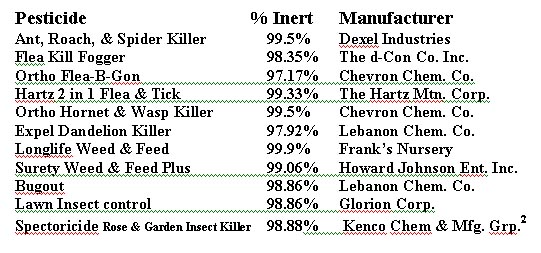


June 2004
by Rose Marie Williams, MA
What Is Meant by "Inert" Ingredients?
When
asked what the term "inert" means, most people
respond with the commonly accepted dictionary meaning of the word,
assuming "inert" refers to inactive, neutral, non- reactive,
powerless, and so on. When consumers read pesticide product labels
this is exactly what they believe "inert" ingredients
to be — neutral and inactive, certainly nothing dangerous or
toxic.
A wonderful booklet published by the Office of the New York State Attorney
General, titled, "The Secret Hazards of Pesticides: Inert Ingredients," is
quite an eye opener for the uninformed. It acknowledges, "many people
will conclude the term 'inert' could not possibly have any adverse
health or environmental effects. This is not the case at all. Chemicals used
as inerts include some of the most dangerous substances known…suspected
carcinogens…linked to long-term health problems like central nervous
system disorders, liver and kidney damage and birth defects. They can also
cause short-term health effects like eye and skin irritation, nausea, dizziness
and respiratory difficulty."1
The United States Environmental Protection Agency (EPA) is responsible for
regulating the use of pesticides and for protecting the public and environment
from dangerous substances. EPA categorizes "inert" ingredients
into four groups: substances known to cause long-term health damage and harm
the environment, chemicals suspected of damaging health or the environment,
chemicals of unknown toxicity, and those of minimal concern. EPA has published
a list of chemicals used as "inerts," but does not indicate which
products contain which chemicals. This is of no help to the consumer.1
Even the most conscientious consumer will learn very little from reading pesticide
labels. Pesticide manufacturers are only required to list the "active" ingredient
on product labels, the particular chemical intended to kill or inhibit some
life form. All additional chemicals in the formulations are lumped together
under "inert" ingredients. Pesticide is an umbrella term that
includes insecticides designed to kill insects, herbicides designed to kill
weeds, fungicides designed to kill molds, miticides against mites, and rodenticides
to kill rodents.
The pesticide industry claims it has a right under confidentiality laws to
prevent competitors from learning the ingredients in a product. However, modern
laboratory technology using "reverse engineering" can easily
discern the components of any product formulation. Consequently, it is the
consumer who is left without adequate knowledge of product ingredients, and
the health practitioner attempting to evaluate possible cause and effect of
a patient's symptoms.
Dangerous "Inerts"
"Inert" as used on pesticide product labels is a serious misnomer
that serves only to keep the public misinformed about potentially dangerous exposures
to toxic substances. The following compounds represent a few examples of toxic
chemicals used as "inert" ingredients in pesticide products.
Chloroethane is a suspected carcinogen which can cause eye irritation, abdominal
cramps, nausea, vomiting, liver and kidney damage, nervous system dysfunction,
and blood cell disorders.
Chloroform can cause irritation to eyes and gastrointestinal tract, nausea,
dizziness, fatigue, and respiratory distress; liver and kidney damage; central
nervous system depression; gonadal atrophy; fetal resorpton; coma and death
by cardiac arrest. It is a mutagen and suspected carcinogen.
Cresols can cause skin irritation, burns and inflammation, eye irritation and
blindness, pneumonia, pancreatitis, and central nervous system disorders.
Dibutylphthalate can cause eye and throat irritation, photophobia, conjunctivitis,
nausea and dizziness.
Dimethylphthalate can cause irritation of the eyes, mouth, and throat; dizziness,
abdominal pain, nausea, vomiting and diarrhea; central nervous system depression;
reduced respiratory rate; paralysis and coma.
Hexane is a neurotoxin, which can cause muscle wasting and atrophy.
Methyl Bromide can cause eye and skin irritation; blurred vision, headache,
dizziness, nausea and abdominal cramps, anorexia; bronchopneumonia, pulmonary
edema; brain damage, convulsions and coma; kidney and respiratory failure.
Methyl bromide is also the "active" ingredient in pesticide products
currently used in the cultivation of pumpkins, strawberries, tomatoes, and
ornamental plants.
Toluene is associated with skin, eye and respiratory
irritation; abdominal pain, headache, nausea, dizziness, drowsiness, hallucinations;
anemia; liver
disorders and enlargement; central nervous system dysfunction; coma and death.1-3
Many formulations used as "inert" ingredients are in fact, "hazardous
substances," and are subject to the Superfund Amendments and Reauthorization
Act (SARA). A number of toxic chemical products listed as the "active" ingredient
in some pesticidal products are disguised as "inerts" in other
products, depending on the manufacturer's designation of which pests
are being targeted. Current registration allows hundreds of toxic chemicals
to be listed as "inerts" on pesticide labels.2
At the present time EPA uses a limited set of criteria for evaluating and categorizing "inert" ingredients
based on carcinogenicity, adverse reproductive effects, neurotoxicity, documented
ecological effects, and potential for bioaccumulation. These criteria are limited
and do not take into consideration endocrine disruption, allergic effects,
and chemical sensitization, despite new information suggesting that "inert" ingredients
can have these and other negative impacts on human health. Pets, wildlife and
the environment also suffer from toxic exposure. The greatest impact falls
upon agricultural workers and their families.2
State Petition Seeks
to Disclose "Inerts"
In January 1998, the State Attorneys General of New York, Alaska, Connecticut,
Massachusetts, Minnesota, New Hampshire, Wisconsin, and the Territory of
Guam, later joined by Arizona and Illinois, filed a petition requesting EPA
to require pesticide product labels to disclose the common chemical names
of the "inert" ingredients contained in pesticide products.
The State Petition notes that many chemicals listed as "inerts" are
toxic, and are listed as the "active" ingredients in other
pesticide formulations. These same "inerts" may be listed as "hazards" under
other federal statutes. The State Petition further notes the failure to disclose "inert" ingredients
poses "serious and ongoing risks to public health because it deprives
the public of the ability to assess and address exposure to these toxic substances."4
Because of the health risks the State Petition requested expeditious action
from the EPA. More than three years later, EPA had not rendered a decision
on the matter prompting the states to compel EPA to act on the State Petition
in which the states were seeking: a declaratory judgment declaring EPA had
unreasonably delayed acting on
the State Petition, and that such delay was unlawful; an injunction requiring
EPA action within 60 days of the Court's determination that EPA's delay is
unreasonable.
The State Petition acknowledged the United States Environmental Protection
Agency as the agency responsible for the regulation of pesticides and the protection
of public health from pesticide risk and exposure.4
The State Petition reiterated that pesticide formulations consist of one or
more "active" ingredients, which are intended to kill or repel
the target pest, and numerous other ingredients, which are known as "inert" or "other" ingredients.
An "inert" is defined as an ingredient, which is not active.
The Petition further notes that "inert" ingredients are not necessarily
safe or inactive, and that even EPA acknowledges some "inert" ingredients
are currently, or have been, listed as the "active" ingredient
in many pesticide products.4
The current labeling regulation stipulates that only the "active" ingredient
be identified by name on a product label. Only eight "inerts" out
of approximately 2,300 "inert" ingredients are required to be
listed on labels because EPA has determined them to be of "toxicological
concern," despite the known and suspected toxicity that hundreds of
additional "inerts" pose to public health. Therefore, in January
1998, the Attorneys General of nine states and the Territory of Guam jointly
submitted a Petition to Require Disclosure of Inert Ingredients on Pesticide
Product Labels. The Northwest Coalition for Alternatives to Pesticides (NCAP)
and 180 other organizations filed a similar petition to require disclosure
of "inert" ingredients on product labels. By June, an additional
80 organization signed onto the NCAP petition.4
A March 12, 1998, letter from EPA's Office of Pesticide Programs (OPP)
to New York Assistant Attorney General, Andrew Gershon, acknowledged receipt
of the State Petition indicating the Petition was "welcomed" as
contributing to the (inert ingredient) dialogue, and that it would be "closely
examined" by EPA. A November 1, 1999, follow-up letter to AAG, Gershon,
stated that EPA was setting up a "working group" to advise EPA
on ways of making information on "inert" ingredients more available
to the public, but did not include a plan or timetable. For three years EPA
did nothing to resolve the "inert" ingredient issue. The plaintiffs
considered EPA's delaying action and failure to respond to the State
Petition "unlawful."4
Carolyn Cox, staff scientist for the Northwest Coalition Against Pesticides
(NCAP), has been a major force representing the many environmental and health
organizations demanding disclosure of all ingredients on pesticide product
labels. Ms. Cox was even appointed to EPA's "working group," to
represent the many health and environmental organizations demanding full disclosure
of all "inert" ingredients. EPA wanted the "working group" to
arrive at a consensus, but industry representatives refused to budge as did
those representing public health concerns. The result is that EPA decided on
voluntary disclosure as per industry's request.5
Percent "Inerts" in
Sample Products
A quick look at some pesticide products illustrates the high percentage
of "inert" ingredients
in the formulations.

It bears mentioning that the chemical companies that manufacture pesticides are intimately involved with the petrochemical/agrichemical/pharmaceutical industries. Increased numbers of grassroots health advocates are becoming wary of the fact that many pharmaceutical companies that produce drugs to treat cancer also manufacture toxic pesticides suspected of promoting cancer.
Consumer Action
Advice from Carolyn Cox to consumers is to avoid toxic pesticide products whenever
possible, and if your workplace or municipality uses such products, bring
up the issue of "inert" ingredients as potentially harmful
chemicals. Ask that someone contact the pesticide manufacturer requesting
to know what the "inert" ingredients are. She said, "Pesticide
companies need to hear from their customers." The NCAP web site (www.pesticide.org)
contains a sample letter for inquiring about "inert" ingredients.
Ms. Cox indicated she would be happy to discuss the issue with anyone who
wished to inquire further. She can be reached at 541-344-5044, or info@pesticide.org.
Residents of states not yet included in the "State Petition" requesting
that EPA require pesticide manufacturers to disclose all ingredients on product
labels may wish to encourage their attorneys general to sign onto this important
document in support of public health. The more states that sign onto the petition
should bolster EPA's ability to act on behalf of public health instead
of giving in to corporate demands. The public and the medical profession have
a right to know this information.
![]()
References
1. "The Secret Hazards of Pesticides: Inert Ingredients," Office
of the Attorney General of New York State, Environmental Protection
Bureau, Albany, NY (518-474-5481), January 1999.
2. States of NY, CT, AK, & MA (Plaintiffs) v. US EPA (Defendants), "Complaint
for Declaratory and Injunction Relief" Civ. No. 1:01CV00379
(PLF), Exhibit A, January 1998.
3. National Pesticide Telecommunications Network (NPTN), 800-858-7378.
4. States of NY, CT, AK, & MA (Plaintiffs) v. US EPA (Defendants), "Complaint
for Declaratory and Injunction Relief" Civ. No. 1:01CV00379
(PLF), January 1998.
5. Cox, Carolyn, Northwest Coalition Against Pesticides (NCAP), Eugene,
OR, (541-344-5044).
Search
our pre-2001 archives
for further information. Older issues of the printed magazine are also
indexed for your convenience.
1983-2001
indices ;
1999-Jan. 2003 indices
Once you find the magazines you'd like to order, please use our
convenient form, e-mail subscriptions@townsendletter.com,
or call 360.385.6021 (PST).
All rights reserved.
Web site by Sandy Hershelman Designs

